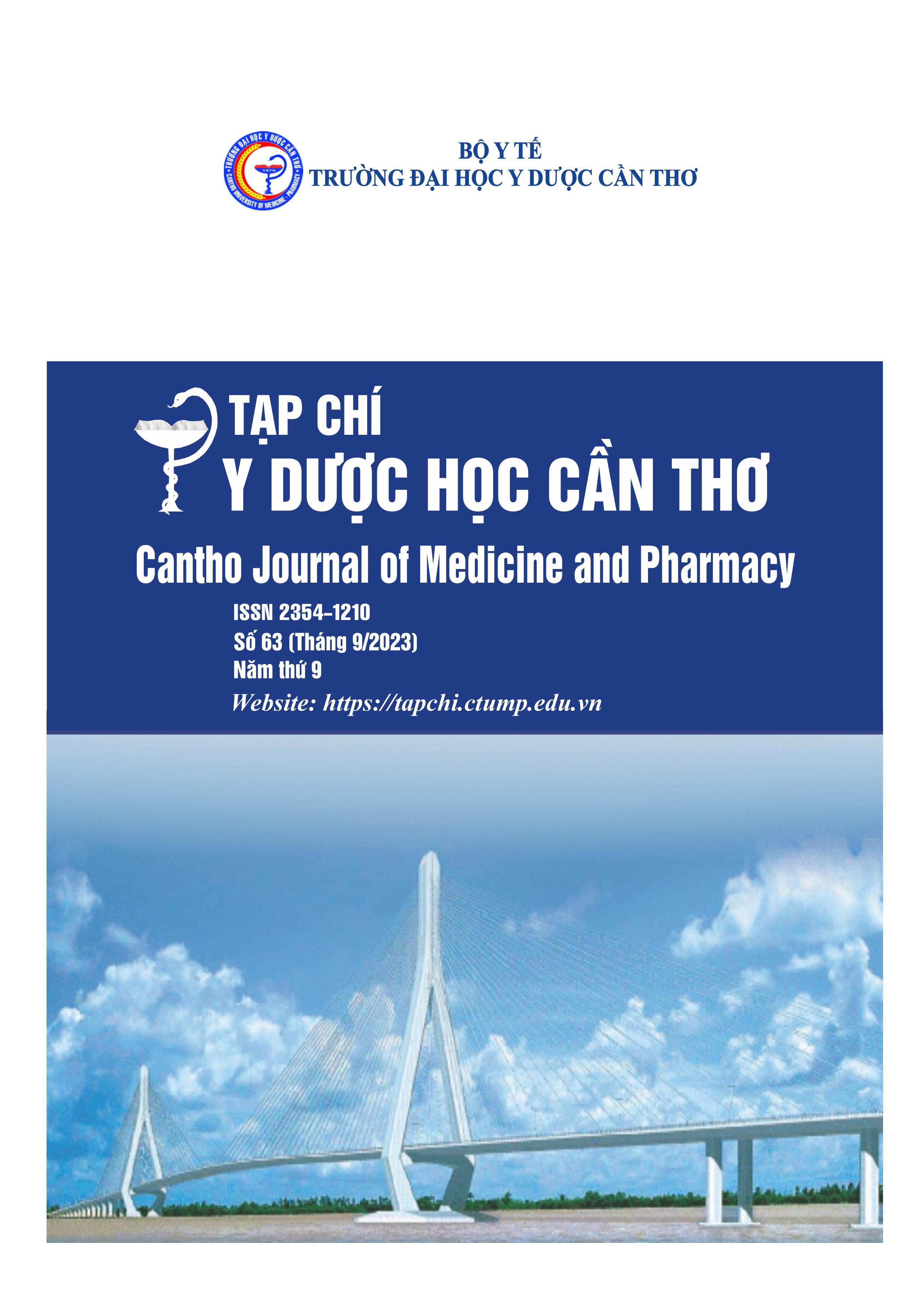NGHIÊN CỨU ĐẶC ĐIỂM GIẢI PHẪU CHÂN RĂNG, HÌNH THÁI HỆ THỐNG ỐNG TỦY PHỤ VÀ EO NỐI Ở RĂNG CỐI LỚN THỨ NHẤT HÀM DƯỚI NGƯỜI VIỆT TRƯỞNG THÀNH
Nội dung chính của bài viết
Tóm tắt
Đặt vấn đề: Hiểu biết về giải phẫu và biến thể của hình thái học ống tủy cũng như ống tủy phụ, eo nối và ống tủy gian ống góp phần đáng kể vào thành công của điều trị nội nha. Mục tiêu nghiên cứu: Mô tả đặc điểm giải phẫu chân răng, hình thái hệ thống ống tủy phụ, eo nối và ống tủy gian ống ở răng cối lớn thứ nhất hàm dưới người Việt. Đối tượng và phương pháp nghiên cứu: Thiết kế nghiên cứu mô tả cắt ngang 179 răng cối lớn thứ nhất hàm dưới được thu thập, xử lí, chụp phim cắt lớp điện toán chùm tia hình nón và khảo sát các đặc điểm: (1) số lượng, kích thước chân răng; (2) số lượng, phân loại ống tủy chính; (3) tỉ lệ, vị trí và phân loại của ống tủy phụ; (4) tỉ lệ, vị trí của eo thắt và ống tủy gian tủy. Kết quả: Răng cối lớn thứ nhất hàm dưới có chân gần (13,22±1,20mm) dài hơn chân xa (12,88±1,10mm) (p<0,001) có 3, 4, 5 ống tủy chiếm tỉ lệ lần lượt là 54,8%, 43,0% và 2,2%. Chân gần cho thấy ống tủy loại I chiếm tỉ lệ cao nhất (65,4%), loại II với 23,5% và 0,6% loại 2-3. Chân xa cho thấy loại I với 61,5%; 0,6% loại 3-1 và 0,6% loại 2-3. Ống tủy phụ xuất hiện với tỉ lệ 40,2%, thường ở vị trí phần ba chóp (56,5%) và loại I chiếm tỉ lệ cao nhất với 62,0% và không thấy sự khác biệt có ý nghĩa thống kê giữa bên trái và bên phải (p=0,851). Kết luận: Chụp phim cắt lớp điện toán chùm tia hình nón nhằm khảo sát đặc điểm chân răng, hệ thống ống tủy và biến thể cũng như ống tủy phụ, eo nối, ống tủy gian ống rất phức tạp và cần phải đánh giá một cách cẩn thận trước khi điều trị nội nha.
Chi tiết bài viết
Từ khóa
Răng cối lớn thứ nhất hàm dưới, ống tủy phụ, eo thắt, ống tủy gian tủy.
Tài liệu tham khảo
2. Kulakov A. A., Badalyan V. A. Increasing the effectiveness of mandibular molars root resection surgery using retrograde endodontic revision. Stomatologiia. 2018. 97(1), 33-36. https://doi.org/ 10.17116/stomat201897133-36.
3. Madani Z. S., Mehraban N., Moudi E., et al. Root and canal morphology of mandibular molars in a selected Iranian population using cone-beam computed tomography. Iran Endod J. 2017. 12(2), 143-148, https://doi.org/10.22037/iej.2017.29.
4. Marceliano-Alves M. F., Lima C. O. Mandibular mesial root canal morphology usingmicrocomputed tomography in a Brazilian population. Aust Endod J. 2019. 45(1), 51-56, https://doi.org/10.1111/aej.12265
5. Filpo-Perez C., Bramante C. M., Villass-Boas M. H. Micro-computed tomographic analysis of the root canal morphology of the distal root of mandibular first molar. J Endod. 2015. 41(2), 231236, https://doi.org/ 10.1016/j.joen.2014.09.024
6. Ahmed H. A., Abu-bakr N. H., Yahia N. A., et al. Root and canal morphology of permanent mandibular molars in a Sudanese population. Int Endod J. 2007. 40(10), 766-771. https://doi.org/ 10.1111/j.1365-2591.2007.1283.x
7. Al-Qudah A. A., Awawdeh L. A. Root and canal morphology of mandibular first and second molar teeth in a Jordanian population. Int Endod J. 2009. 42(9), 775-784. https://doi.org/10.1111/j.13652591.2009.01578.x.
8. Gu L., Wei X., Ling J., Huang X. A Microcomputed tomographic study of canal isthmi in the mesial root of mandibular first molars in a Chinese population. J Endod. 2009. 35(3), 353-356. https://doi.org/ 10.1016/j.joen.2008.11.029.
9. Peiris R., Malwatte U., Abayakoon J., Wettasinghe, A. Variations in the Root Form and Root Canal Morphology of Permanent Mandibular First Molars in a Sri Lankan Population. Anatomy
Research International. 2015. (3), 803671, https://doi.org/ 10.1155/2015/803671
10. Dastgerdi A. C. Isthmuses, accessory canals, and the direction of root curvature in permanent mandibular first molars: an in vivo computed tomography study. Restor Dent Endod. 2020. 45(1), e7, https://doi.org/ 10.5395/rde.2020.45.e7
11. Harris S. P., Bowles W. R., Fok A., McClanahan S. B. An anatomic investigation of the mandibular first molar using micro-computed tomography. J Endod. 2013. 39(11), 1374-1378. https://doi.org/ 10.1016/j.joen.2013.06.034.
12. Keleş A., Keskin C. A micro-computed tomographic study of band-shaped root canal isthmuses, having their foor in the apical third of mesial roots of mandibular frst molars. Int Endod J. 2018. 51(2), 240-246. https://doi.org/ 10.1111/iej.12842
13. Huỳnh Hữu Thục Hiền, Hoàng Tử Hùng. Đặc điểm hình thái chân răng và ống tủy răng cối lớn thứ nhất và thứ hai người Việt. Luận văn Tiến sĩ. Trường Đại học Y Dược Thành phố Hồ Chí Minh, Hồ Chí Minh. 2019. 59-61.
14. Nguyễn Hoàng Thy Vân, Huỳnh Hữu Thục Hiền. Đặc điểm hình thái chân răng và ống tủy xa trong răng cối lớn thứ nhất hàm dưới người Việt. Luận văn tốt nghiệp Bác sĩ Răng Hàm Mặt, Trường Đại học Y Dược Thành phố Hồ Chí Minh, Hồ Chí Minh. 2017. 40.
15. Ahmed H., Versiani M. A new system for classifying root and root canal Morphology. Int Endod J. 2017. 50(8), 761-770, https://doi.org/ 10.1111/iej
16. Gupta A. Prevalence of Three Rooted Permanent Mandibular First Molars in Haryana (North Indian) Population. Contemp Clin Dent. 2017. 8(1), 38-41. https://doi.org/: 10.4103/ccd.ccd_699_16
17. Khlaghi N. M., Khalilak Z., Vatanpour M., Mohammadi S., Pirmoradi S., et al. Root Canal Anatomy and Morphology of Mandibular First Molars in a Selected Iranian Population: An In Vitro Study. Iran Endod J Winter. 2017. 12(1), 87-91, https://doi.org/ 10.22037/iej.2017.18.


